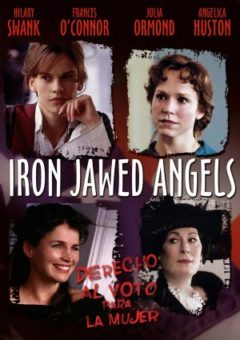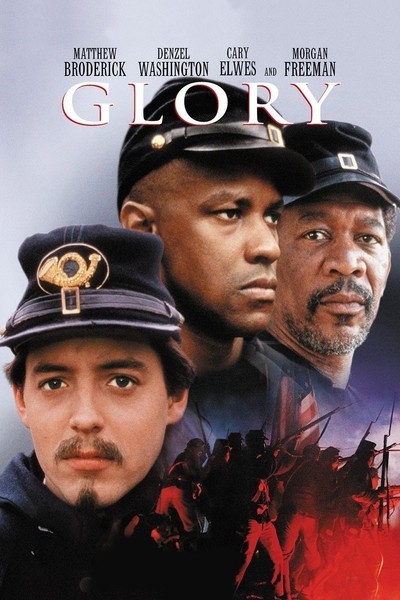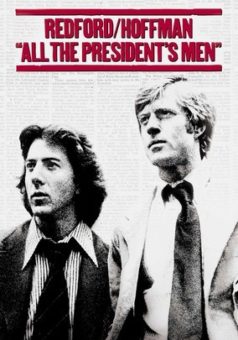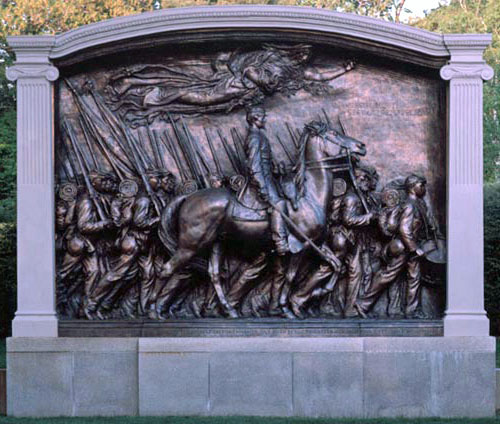Showing Movies in Class: It’s Not Just for Subs
A MiddleWeb Blog

Yet when it comes to showing entire movies in class, sometimes I feel guilty. If middle schoolers are watching a film for the whole week, what am I doing? Is this really the best use of students’ time, or should they be doing something more rigorous, such as writing an analytical paper or reading primary source documents?
This spring I ended up showing more movies than usual – three films in short succession, during third and fourth quarters – because they fit with the themes I wanted to teach, in addition to building empathy for how hard it can be to institute change.

For any film, I make sure the students have background before they see it, whether from a unit we’ve already finished or from background information they have read beforehand. Iron Jawed Angels fits with our unit on reformers and women’s history, Glory stands as the centerpiece for our unit on civil rights during the Civil War, and All the President’s Men connects with the spirit of our reformers unit in addition to showing students how investigative political reporters do their jobs, then and now.
Understanding the challenges of women winning the vote
In the past, I had showed students Iron Jawed Angels (similar in theme and content to the more recent Suffragette) with a substitute teacher while I was attending a conference. This year I was able to be in class for all of it.
Sitting in the room allowed me to pause to explain important moments, such as when Ida Wells-Barnett said that African-American suffragists would not march at the back of the a women’s rights parade. I was also able to connect then to now, mentioning the concept of intersectionality and reminding students that some women of color had wanted to sit out the January 2017 women’s march for similar reasons.

To read about the hardships inherent in the suffragist and anti-suffragist movements in the early part of the twentieth century is one thing; to watch Hilary Swank be force-fed raw eggs in solitary confinement in prison is entirely another. Students’ visceral understanding of the barriers to change became a touchstone we could refer to throughout the semester, as well as an image they could remember if they ever wanted to enact difficult reforms.
Learning the links of the Civil War to civil rights
Similarly, showing the classic film Glory (1989) as part of a unit on civil rights during the Civil War has yielded benefits far beyond what I expected when I incorporated it into class four years ago. After reading excerpts from Robert Gould Shaw’s letters and seeing images of sculptor Augustus Saint-Gaudens’ memorial to Shaw and the 54th Massachusetts Regiment, students recognize the dynamic evolution the commander underwent, from a reluctant abolitionist to a committed leader of African-American soldiers. Through the detailed and accurate battle scenes, they also understand that war is not all glamorous.
As Audrey wrote in her reflection after the film: “I never imagined that so many people would have fallen on the battlefield, and that after seeing such things, that people could go back to the camps and sing and play. It humanized war for me.”
And Melanie focused on the discrimination African-Americans faced in the military at that time: “They could march well, they could shoot with precision, and they went down fighting. The thing that made them different from white soldiers was the way they were treated.”

Beyond the thematic and linguistic overlaps, however, both she and I were delighted when students made many connections on their own, such as applying the idea of “code-switching” to the film after they learned what the phrase meant in English class.
Understanding investigative journalism
The third film, All the President’s Men, was one I had initially wondered if eighth graders would be as mesmerized by as I was. The detective story of Bob Woodward and Carl Bernstein staking out sources takes a good 138 minutes to spool out, and I thought students might not stay attuned to the whole thing.
But with a little background on the key terms and people in the film, as well as a few pauses to explain now-obscurities such as Ed Muskie’s 1972 primary run for president, the eighth graders stayed committed during the entire movie and even groaned a bit some days when we needed to stop.

Evaluating movie ratings
Of course, all three of these films contain intense images and language. All the President’s Men is rated PG, and Iron Jawed Angels (a TV movie) is not rated, but Glory has an R rating.
As the teaching site Interact: Learn Through Experience notes, however, in an introduction to an excellent viewing guide for the film: “Though rated R, Glory only has a few scenes with potentially objectionable material—mostly brief instances of language and a couple of bloody battle scenes. There are no scenes that involve nudity or sexual situations, and none of the violence is sadistic or sensationalized.”
As many middle and high school history teachers do, with a film that is R-rated or that I think could be controversial, I will usually send home a letter to parents explaining how the movie fits into our curriculum and giving students the chance to opt out, though they almost never choose to do so.
I also tell students, as gross or gory images play across the screen, that they should feel free to close their eyes. At the same time, I remind them why it’s important to know that such images exist – for instance, to fully understand the horrors of war or to realize how much jail conditions have improved in some ways from a century ago.
And I definitely keep in mind that the typical sixth grader’s tolerance for such intensity is very different from a seventh or eighth grader’s ability to assimilate it, because the development from year to year in middle school is so vast. I choose the films carefully precisely because their impact can be so enduring, creating images of powerful role models that students could someday emulate.
































Many thanks for this post! I also feel the teacher guilt from “pressing the play button”, even for a 10-minute video let alone a feature-length film. You inspired me to consider showing all of Glory (after sending the parent letter home of course), not just the short clips that I’ve used in the past. All the President’s Men is a particularly intriguing option.
Andrew, thanks for these kind comments. If you use either of these films or others, please let me know how it goes!
Sarah, films are so powerful, and make history far more human than a textbook or even a mini-lecture. They put the student right there. Your movies have been well chosen and you guide your students with objectives, so they are far more than a time filler. Good article.
Mary, thank you for reading! I love your phrase that films “put the student right there.” This summer I’m hoping to watch a few more great historical movies to think about showing in future years.
Thanks for your insight. I used Angela’s Ashes movie with the novel. It turned out to be outstanding. This was in May for a 12th grade high school class. Many good elements in the movie and book point to the trouble that an alcoholic parent brings to a family…a good dose of preventative for prom going underage seniors!
Ann Marie, what a perfect idea for seniors. Sounds like a powerful lesson!
I have used Glory with 8th grade in the past. I found that by skipping about 2 min when the drill sergeant first comes out, you can bypass most all of the foul language.
Ryan, this is a great idea, as that is a particularly intense scene. Thanks for sharing it.
Thank you for this. I show Saving Private Ryan for 11th grade US History WWII unit and my students love it. It really shows the human cost of war in a way that I am unable to describe to them. The key is watching it with them and then having the important conversations!
Robin, your description of the “human cost of the war” is so true. Thanks for this suggestion.
Hi, again, Sarah. Hidden Figures is a great one for Women’s History Month or any time and Lion, taken from a real-life memoir, will show the real poverty and conditions in other countries.
Mary, I love these suggestions! And I just saw Lion this weekend – it was magnificent and captivated my 9- and 12-year-old sons. Thanks again.
I applaud this teacher for the way she uses film to engage her students. However, I wished she had engaged them even more in a “close read” of the techniques filmmakers use which imply meaning. With an understanding of film literacy, teachers could (for example) ask students why a director would have done a slow zoom of the camera on a character’s face; why the music shifted from major to minor chords; how lighting, set design, and costume selection all help communicate mood and more.
Understanding directors’ choices as well as the filmmaking techniques are both part of the middle grades ELA Common Core standards. When teachers take time to point out these elements, they are helping make the movie watching experience a richer and more rewarding one.
Frank, thank you for pointing out this excellent ELA connection.Your ideas of analyzing the film in multiple ways definitely connect history to English, and I enjoy asking students about these details. As a history teacher, I struggle with how much time to include on such stylistic versus historical analysis, but often one feeds the other. In “All the President’s Men,” one camera choice used a couple of times is to zoom far out in an aerial shot (the Library of Congress and, later, D.C.) to show the seeming futility of Woodward and Bernstein’s quest.
When used correctly, movies can be valuable resources. Merely pressing ‘play’ with no preparation or review is useless. I wonder, though, about the benefit or detriment of people of color always being shown as victims, and people that events happen to. What effect does that have on students of all races? To Kill a Mockingbird is a perfect example. Glory is a bit better on that front, as it shows African American men taking action and not merely being victimized.
My school’s population is predominantly white. How will an African American student feel being subjected to the so-called “n-word” over and over again? I don’t know if it’s worth showing Glory in its entirety or reading To Kill a Mockingbird, at least in middle school. A few years ago, after we studied compromises at the Constitutional Convention, a white student told a black student that he (the black student) was only 3/5 of a person. I dealt with it firmly. The point is, no matter how much preparation we do, these things happen. I try to keep in mind that one African American, Asian, or Latino student in a class full of white kids. White students get to see and read about a wide variety of white characters. Students of color deserve the same. Just thinking out loud. Thanks for your post.
Fran, thank you for your thoughtful comment. Your points are very well made.